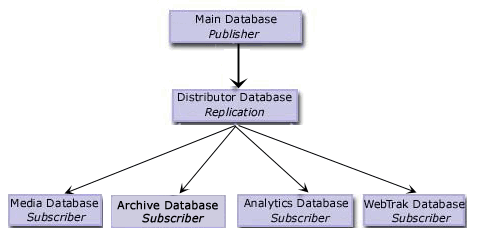Database Replication
Database replication is the process of copying the whole or parts of a database so that two or more copies can exchange updates of data or replicated objects. This exchange is called synchronization. Each copy of the database is called a replica and each contains a common set of tables, queries, forms, reports, macros and modules. Each replica can also contain local objects that exist only in that specific replica.
The primary use of replication is to reduce load on the primary database server. This speeds up the system by enabling Main database to focus on Interaction management, and Media database to control the chat feature. Reports generation and viewing is done from Analytics database. WebTrak database is used by the proactive chat feature to track visitors to the institution's website.
The following database replication model is implemented:

Database Replication Model
The Database Replication Process
Main database contains all the tables used by the system. It registers as a publisher with the distributor database. A publisher is a server that makes data available for replication to other servers. In addition to identifying which data is to be replicated, the publisher detects that data that has changed and maintains information about all publications at that particular location in the database.
Tables relevant to the Media functionality are replicated in Media database and tables relevant to the analytics functionality are replicated in Analytics database. These databases are registered as subscribers with Main database. Subscribers are servers that store replicated data and receive updates.
Main database pushes updates to the subscribers on a regular basis. This increases accuracy of the data stored in the databases and avoids overloading the network with polling for updates.
During replication, all the SQL Servers should be running under a domain account that has access to the network. If the Microsoft® SQL Server™ is running in a Windows Domain environment, ensure that all the computers are logged on to with the same login user name and password.
For more information, refer to the following topics on the Microsoft® SQL Server™ Books Online:
• Replication Distribution Agent Utility.
• Replication Log Reader Agent Utility.
• Replication Snapshot Agent Utility.
The Snapshot agent is scheduled to run every 30 seconds.
A table created is reflected in the subscribing database within 45 seconds.
|
Tip A replication failure or deadlock can be resolved by the snapshot agent. This agent is scheduled to run every 30 seconds. |